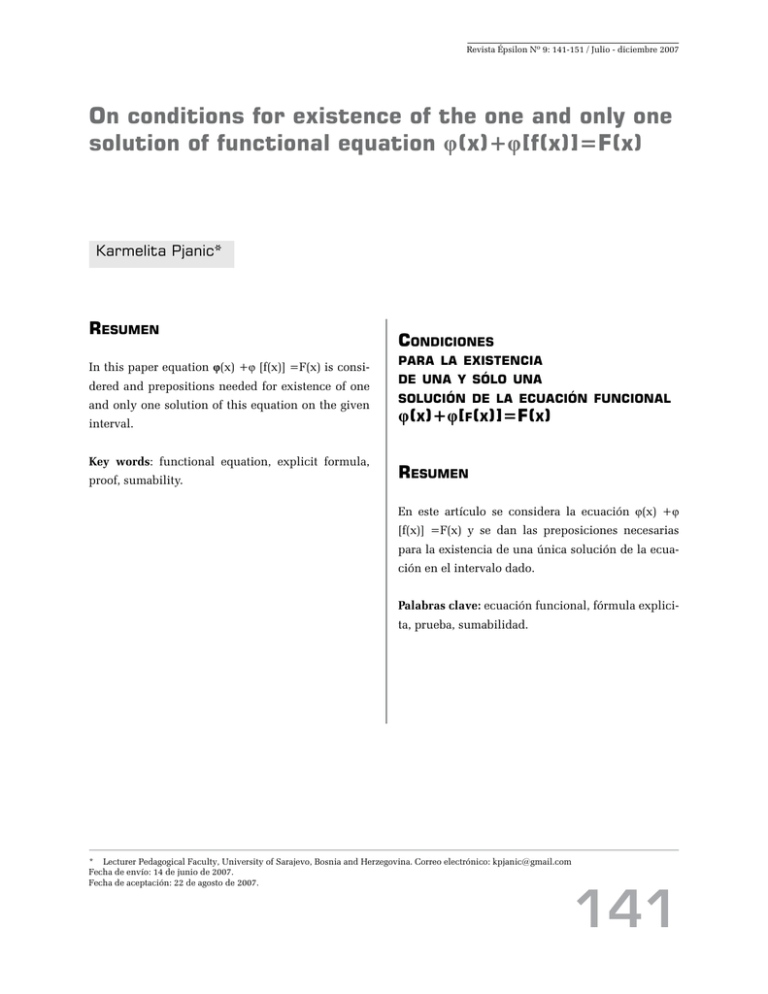On conditions for existence of the one and only one solution of
Anuncio

Revista Épsilon Nº 9: 141-151 / Julio - diciembre 2007 On conditions for existence of the one and only one solution of functional equation φ(x)+φ[f(x)]=F(x) Karmelita Pjanic* RESUMEN In this paper equation φ(x) +φ [f(x)] =F(x) is considered and prepositions needed for existence of one and only one solution of this equation on the given interval. Key words: functional equation, explicit formula, proof, sumability. CONDICIONES PARA LA EXISTENCIA DE UNA Y SÓLO UNA SOLUCIÓN DE LA ECUACIÓN FUNCIONAL φ(X)+φ[F(X)]=F(X) RESUMEN En este artículo se considera la ecuación φ(x) +φ [f(x)] =F(x) y se dan las preposiciones necesarias para la existencia de una única solución de la ecuación en el intervalo dado. Palabras clave: ecuación funcional, fórmula explicita, prueba, sumabilidad. * Lecturer Pedagogical Faculty, University of Sarajevo, Bosnia and Herzegovina. Correo electrónico: [email protected] Fecha de envío: 14 de junio de 2007. Fecha de aceptación: 22 de agosto de 2007. 141 Revista Épsilon Nº 9 / Julio - diciembre 2007 The results of this paper are related to conditions un- Those results are given in the Theorems 2, 4, 5 and der what functional equation 6. φ(x) + φ[f(x)] = F(x) , (1) Theorem 2 and Theorem 4, consider different cases of sumability of series (3), and give sufficient con- where φ(x) denote unknown function, and f(x) and ditions for existence of the only one solution of (1). F(x) are known functions, has one and only one so- Theorem 5 and Theorem 6 give sufficient conditions lution. for existence of the only one continuous solution of (1) in (a, b]. Kuczma (1959) proves that under some natural assumptions equation (1) has infinitely many solutions Results on the series (4) can be obtained analogi- continuous for every x that is not a root of equation caly. f(x) = x . The next assumptions will be valid in the all fo- (2) llowing theorems. In the same paper, under assumption that solution is continuous for x = x0 satisfying (2), existence of a 1. Function f(x) is continuous, strictly increasing in most such solution is proved. the interval [a, b], and f(a) = a, f(b) = b, Some solutions of the equation (1) were examined f(x) > x, x by Malenica (1980a, 1980b) and Pjanic (2006, 2007). Pjanic (2007) gives assumptions needed for existen- (a, b). 2. f 0(x) = x, f ν+1(x) = f[f ν(x)], ν = 0, ±1, ±2,... ce of the most one solution of equation (1) that can be given by an explicit formula. THEOREM 2. Let function F(x) be defined in [a, b]. Next theorem is proved in Kuczma (1959) a) If series (3) converges in [a, b],then its sum φ(x) is THEOREM 1. Given (1). If F(x) is continuous and if solution of equation (1). f(x) is continuous and strictly increasing in [a,b] and if there exist functions φ(x) and ψ(x) that fulfill (1) and b) If series (3) is T-sumabile with the sum φ(x), where are continuous in (a,b] and [a,b) respectively, then T is a matrix (3) T=(akn) = (4) In this paper will be presented results on some of the features of the series (3). Those results are connected whose elements akn satisfy following conditions to sumability of the series (3) as well as the proof of (i) akn→0 ( k → ∞, n0 ), the existence of the only one solution of the equation (1) that is continuous in the interval (a, b]. (ii) │ak0│+│ak1│+...+│akn│<k , (n, fixed) 142 / Karmelita Pjanic k Revista Épsilon Nº 9 / Julio - diciembre 2007 Note that considering cases c) and d) is justified sin(iii) (k→∞), ce there is no assumptions about sumability of the F(x). then φ(x) is one solution of (1) if Proof. a) The statement can be proved directly by │F(x)│ M,x [a, b] ; , where changing φ(x) in (1) by series (3), that is F(x) is bounded in [a, b], continous from left in b. c) If series (3) is Ck-sumabile with the sum φ(x), then φ(x) is one solution of (1). d) If series (3) is A-sumabile with the sum φ(x), then φ(x) is one solution of (1). =F(b) + F(x) –F(b) =F(x) + F(x). b) By putting ( n = 0, 1, 2, ... ) ( k = 0, 1, 2, ... ) and taking in the account assumption on T-sumability of the series (3), it gives On the other hand, it can be easily shown that Namely, , On conditions for existence of the one and only one solution of functional equation φ(x)+φ[f(x)]=F(x) 143 Revista Épsilon Nº 9 / Julio - diciembre 2007 so = = = = , i.e. Now, it is = = = . i.e. . Last term on the right side of relation (5) can be evaluated on following way (k k0), where fixed number N is chosen big enough so that │F(f n+1(x))-F(b)│ 144 / Karmelita Pjanic (n N+1), (5) Revista Épsilon Nº 9 / Julio - diciembre 2007 and with such number N fixed, whole number k0 (k 0 chosen so that k0, n = 0, 1,....,N). Now, for k → ∞ relation (5) takes form i.e. φ(f(x)) = F(x)-φ(x). c) Using well known fact (6) let us prove that (7) . (8) From (6) follows The equality (7) is proved. On conditions for existence of the one and only one solution of functional equation φ(x)+φ[f(x)]=F(x) 145 Revista Épsilon Nº 9 / Julio - diciembre 2007 Let us prove (8). Adding and gives The sum of the first three addents is equal to 146 / Karmelita Pjanic Revista Épsilon Nº 9 / Julio - diciembre 2007 Using previously given relations it follows . Now, by applying well known features of binomial coeficients in the sum A we get . (9) Hence, from (9) it follows , i.e. the equality (8). Leting n → ∞, and taking in account assumption on Ck-sumability of the series (3), it follows , , , , On conditions for existence of the one and only one solution of functional equation φ(x)+φ[f(x)]=F(x) 147 Revista Épsilon Nº 9 / Julio - diciembre 2007 i.e. . d) Puting and taking in the account assumptions of the Theorem 2 as well as the assumptions given before Theorem 2, it can be easily calculated that Let t↑1. Then, by assumption on A-sumability of the series (3), series converges for t↑1, thus . Theorem is proved. Proof. According to Theorem 2b) function φ(x) is one Next theorem, which is proved in Pjanic(2007), will solution of the equation (1) in (a,b]. The solution φ(x) be needed in the following part of paper. is continuous in (a,b], by assumption. THEOREM 3. Given equation (1) where F(x) is continuous and f(x) continuous and strictly increasing in [a,b]. Then (1) has at most one solution continuous in [a,b) and at most one solution continuous in (a,b]. Now, from Theorem 3 and Theorem 1 it follows that φ(x), given by (3), is the only continuous solution of equation (1) in (a,b]. THEOREM 5. Given equation (1) where F(x) is continuous and f(x) is continuous and strictly increasing It is easy now to prove next theorem. in [a,b]. If THEOREM 4. Given equation (1) where F(x) be con- (10) tinuous and f(x) continuous and strictly increasing in [a,b]. If series (3) is T-sumabile with the sum φ(x) or continuous in (a, b], then series (3) is convergent in (11) (a,b] with the same sum φ(x). Function φ(x) is the only continuous solution of the equation (1) in (a,b]. then the only one continuous solution of equation (1) in (a,b] neccessarily exists. 148 / Karmelita Pjanic Revista Épsilon Nº 9 / Julio - diciembre 2007 Proof. Suppose that (8) is satisfied. satisfies (B) sn+(n+1)ρn→s. It is sufficient to prove that series (3) is uniformely convergent in interval [h,b] , where h (a,b) is arbi- If σn denote partial sums of (A), and if σ denotes sum of (A), then trary fixed element. Put hν = f (h). Then, there is number N so that (B!) s-sn-(n+1)(σ-σn)→0. ν Now, Theorem 6 can be given and proved. According to (10) it is THEOREM 6. Given equation (1) where F(x) is continuous and f(x) is continuous and strictly increasing in [a,b]. Let G(x) = F(x) – F(b). If If x [h,b], then it can be always founded whole number k so that (i) an = f n(a0) , where a0 is fixed, 0 < a0 < b, (ii) 0 < ωG(x) , x (iii) , ω = 1 or ω = – 1 [an,an+1) , n > n0 >0 , Thus, and where A and α are positive constants, then equation (1) has the only one continuous solution in (a,b]. as Aν → F(b) ( ν → ∞ ). Proof. Suppose that ω = 1. The last evaluation gives uniform convergence of the Note that Theorem 6 stays valid if for the starting interval [a0,a1) one takes interval [ak,ak+1) , (for k whole series (3) in [h,b]. number), and changing at the same time n0 by n0 – k. If the condition (11) is satisfied then the statement of the Theorem 5 can be obtained by changing F(x) Now, it has to be proved following: with –F(x) and reapiting procedure. 1° Alternated series (12) In the proof Theorem 6 will be used next theorem proved by Knopp. Knopp’s theorem will be given wiconverges apsolutely and uniformely in [ak,b], thout proof. (k whole number). Theorem (Knopp): Series with partial sums sn is C1-sumabile with sum s, if and only if series 2° Sequence (A) (13) converges uniformely in [a0,b] when n → ∞. is convergent and its reminder (n=0, 1,2,...) On conditions for existence of the one and only one solution of functional equation φ(x)+φ[f(x)]=F(x) 149 Revista Épsilon Nº 9 / Julio - diciembre 2007 Taking in the account previous note, it is sufficient the term under the second apsolute value sign on the to prove 1° in the case k = 0. right side of (14) is less then If x n [an,an+1) (n ≥ 0), put x = f (x0) = xn , x0 [a0,a1) . that, using (ii), gives, Now, relation (14) takes form By this 1° is proved. In order to prove 2° put x = f k(x0) = xk [ak,ak+1) , x0 [a0,a1). Then (13) implies Taking into account that from it finally gives │cn+p(xk)-cn(p)│<ε (14) Simple transformations of the term under first absolute value sing in the right side of (14) give for every n ≥ n0 that is large enough, for every p = 0, 1, 2,... and for every x [a0, b]. Thus, 2° is proved. Puting Furthermore, considering and applying Knopp’s Theorem that gives neccessary and sufficient conditions for C1-sumability of (9), and using Theorem 2c) and Theorem 3, it follows that function φ(x) is the only continuous solution of (1) in [a,b]. For ω = –1 the proof can be conducted in similar way, putting -F(x) instead of F(x). 150 / Karmelita Pjanic Revista Épsilon Nº 9 / Julio - diciembre 2007 BIBLIOGRAPHY Kuczma, M. On the functional equation φ(x)+φ(f(x))=F(x), Ann. Pol. Math. 6 (1959). ---. «Functional equations in a single variable». Monographs Math 46. Warszawa, (1968). Kuczma, M.; B. Choczewski y R. Ger, «Iterative Functional Equations». Encyclopedia Math. Appl., Vol. 32, Cambridge Univ. Press, 1990. Malenica, M. O rjesenju funkcionalne jednacine φ(x)+φ(f(x))=F(x), Akademija nauka i umjetnosti BiH, Radovi LXVI/20, Sarajevo 1980, 103-109 ---. O rjesavanju funkcionalne jednacine φ(x)+φ(f(x))=F(x) i neki specijalni primjeri regularnih transformacija, Akademija nauka i umjetnosti BiH, Radovi LXVIII/6, Sarajevo 1980. ---. personal communication, 2003. Pjanic, K. O funkcionalnoj jednacini φ(x)+φ[f(x)]=F(x), Zbornik radova Pedagoske akademije Sarajevo, submited 2006. ---. On Existence of Solution of Functional Equation φ(x)+φ[f(x)]=F(x), Revista Épsilon Nº 8: 125-129 / Enero - junio 2007 Stenger F. A Function Equation, NA Digest 10, item 2, 1994. On conditions for existence of the one and only one solution of functional equation φ(x)+φ[f(x)]=F(x) 151
